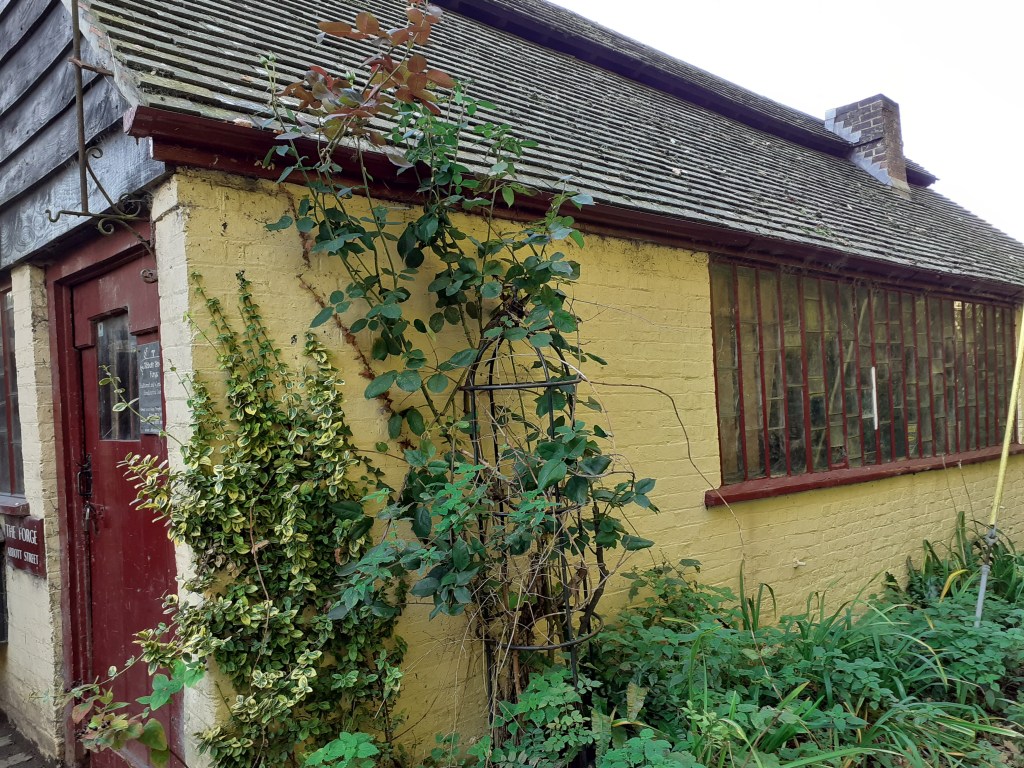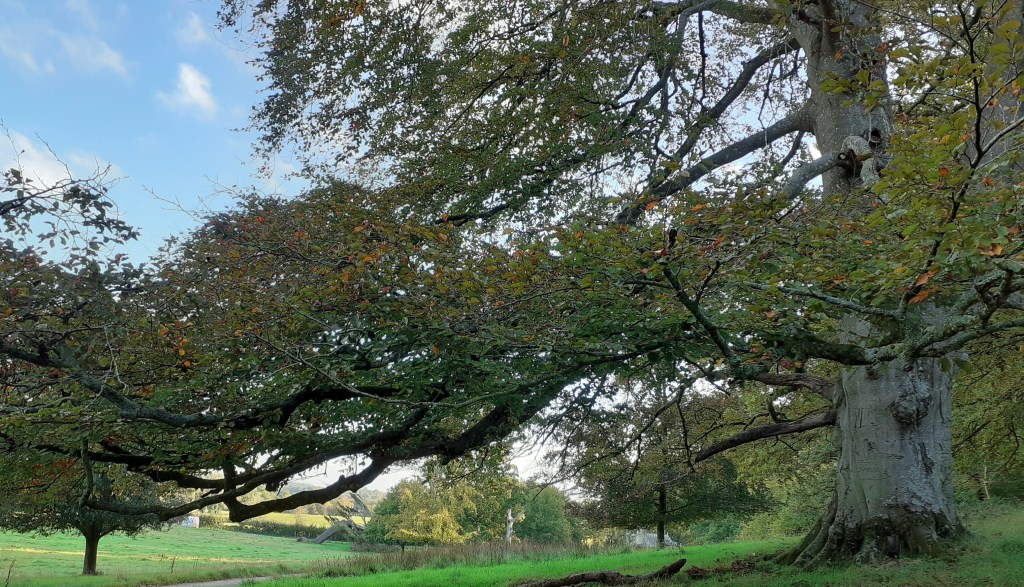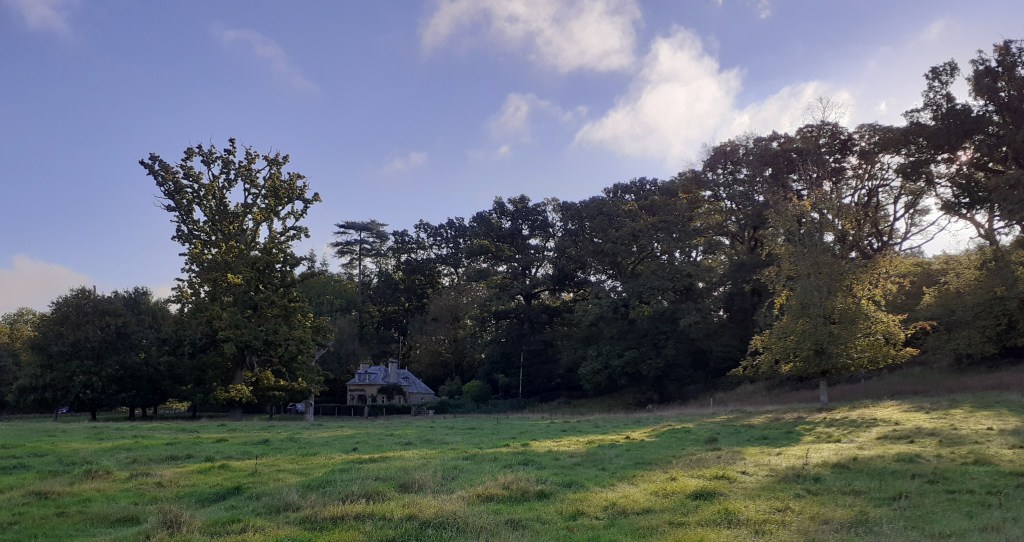
An early morning walk is my new normal because the need to be outdoors, to feel the morning air and the grounding presence of a world larger than mine is overwhelming. It feels strange to walk without the footfall of a companionable horse, but this is now and that was then, and I’m trying to focus on being where I need to be in this part of my life.

The kissing gate leads to a steep footpath through the woods, shaded from light by mature trees. When I pass the tree I call Tall Man the sun breaks through the canopy, and I walk looking up instead of down.

Following the narrow path and avoiding badger setts, I reach Lady’s Walk and the back gate of St. Stephen’s church.

Henrietta Bankes was the chatelaine of Kingston Lacy House. In 1906 her husband Walter Ralph Bankes gave her £5,000 to build the church. Lady’s Walk was her personal path the north door where she’d sit in her own pew, leaving as the last hymn was sung to avoid mixing with the hoi polloi.
The Bankes family have lived in Dorset since the 17th century when they were considered one of the most powerful families in England, owning both the estates of Corfe Castle and Kingston Lacy. In 1643, the Royalist Lady Mary Bankes stayed at Corfe Castle while her husband fought in the Civil War. Corfe Castle was the only Royalist stronghold left in Dorset, and when Parliamentarians attacked, ‘Brave Dame Mary’ held the castle for three-year siege until she was betrayed from within. In recognition of her bravery, the Parliamentarians allowed her to keep the castle seal and keys.
When Henrietta and WRB’s son died in 1981, he left the 16,000 acre estate to the National Trust.

The front of the church catches the full morning sun, and I sit a while on the bench or in the sheltered porchway. The church has no graveyard, just trees planted with plaques of remembrance and a tall stone memorial cross for Mr. Bankes.

Like characters from a Thomas Hardy novel, Mark and I walked the same wooded path from home one July afternoon to renew our wedding vows in this church. The vicar was an eccentric scholar who studied Judaism, and with great tact and understanding he accommodated our wishes of a G-dly but not devoutly Christian service. The three of us stood in an otherwise empty church, I held a posy of flowers cut from Julie’s garden, and it was a most beautiful service. Afterwards we drank a champagne toast, and the vicar provided a napkin to wrap a glass so we could stamp on it and shout l’chaim! Then we went home for tea and cakes.

Leaving the church, I turn right onto the narrow lane. From February ’til early summer the high banks are covered in snowdrops primroses celandine daffodils and bluebells, and natural springwater runs freely down the hill. It freezes in winter which is quite treacherous.

Through a perfectly placed gap in the trees there’s a fantastic view of the fields leading down to the river.

The 19thC forge is a working forge. It laid empty from 1945 until Giles began working there in the mid-nineties, using many of the same blacksmithing tools and techniques in a tradition unchanged for hundreds of years. It has quirky windows made from small panes of overlapped glass that I always want to touch; its like touching history.

The exposed roots of fallen tree remind me of extracted tooth! When I reach the little thatched cottage at the bottom of the hill I turn off the road and walk across the fields.

Ruby Red Devon cattle have grazed here since the 19thC. When the last member of the Bankes family to live at Kingston Lacy gifted the estate to the National Trust, he asked that that herd of Red Devons would always be maintained on the estate. They graze outside our house and their colour and solidness always makes me smile.

I was taking a picture of this tree framing a fallen tree (sometimes I go and sit on the fallen tree) when I heard a rustling behind me

and as I turned round, a startled deer stood motionless for a second before fleeing to safety.

In the grass there’s a fairy citadel of fungi, a row of freshly dug molehills, and a cluster of stinking iris. I Googled why they have such an unfortunate name and its because the leaves smell disgusting if you crush them. For some reason, the birds never eat the berries.

Now I’m on the downward path towards home

and when I reach the low-spread copper beech branches, there’s the first glimpse of our house.

The ancient copper beech tree has initials carved on the bough, it makes me wonder who these people were, sitting with their back against the tree, maybe planning their future together?

Our house is tucked away under the trees and gets little or no sunlight until springtime. I really miss the warmth and cheer.

At the front of the house is our dear fallen hero, the Victorian cedar tree that came down in the rain and high winds just before Christmas. We heard him crash at three in the morning. Some of the roots remained intact, and thankfully the greenery has begun to grow again so he continues his life, albeit from a different perspective.

And back to my own front gate where tea and toast and two cats are waiting inside. Thankyou for coming with me today, it was lovely to have your company and share my walk with you. Perhaps next time we’ll have a walk around Kingston Lacy House and I’ll show you the treasures? xx
Thank you for bringing me along with you. Lovely lively neighborhood.
LikeLike
good to have you along Lasell
LikeLike
Thank you for taking me along with you on your morning walkabout. What a wonderland surrounds you :)) :)) Dawn
LikeLike
I just love it Dawn. A true wonderland.
LikeLiked by 1 person
Beautiful xxxx
LikeLike
thanks Jan x
LikeLike
Thank you Elaine, I enjoyed walking with you through the beautiful Dorset countryside.
LikeLike
thankyou Lainey for coming with
LikeLike
A beautiful walk, and one which no doubt changes magnificently with the seasons.
Like the fallen tree you too are seeing the world, and life from a different perspective now you are no longer high up on the back of Bruce. He gave you his view of the world, now once again you are closer to the earth letting nature do what she does best ground us 💕
LikeLiked by 1 person
you’ve summed it up in a nutshell Sue
LikeLike
Thank you so much for sharing your walk. It has been a beautiful pause in my morning.
LikeLike
lets do it for real one day Ruth?
LikeLike
Thanks go to you for inviting me to join you. What a marvelous walk. The presence of nature implies history, but on our walk even the man-made parts are steeped in history as well. I think perhaps the story of Brave Dame Mary needs to be told! And I would love for you to show me around Kingston Lacy House.
LikeLike
Brave Dame Mary was a truly amazing woman, I might research her some more. And yes, I’ll def do a walk up to the House and show you all its treasures
LikeLike
I would love to take that walk with you. Xxx
LikeLike
I’d love that too Marcia
LikeLike
I so enjoyed my walk with you this morning …thank you for sharing your amazing photos to bring it all more alive
LikeLike
thanks Sarah, I’ve not used my phone for much more than photographing stuff I wnated to remember, and I’m quite surprised at the clarity once I figured out what all the settings were!
LikeLike
Thank you for sharing your walk with me, Elaine. It was quite magical. I think you might live in a fairy tale.
LikeLike
oh, yes, a fairy tale. Until the mud and ice and interminable greyness of English winter arrives it IS a fairy tale Liz
LikeLike
If only we could link arms and stroll a while…
LikeLike
yes Kimberley, if only…
LikeLike
Have really enjoyed this walk and your lovely photos xx
LikeLike
good to have you along myrtleberry
LikeLike